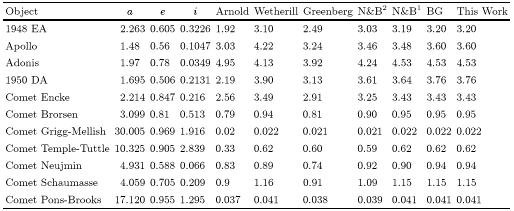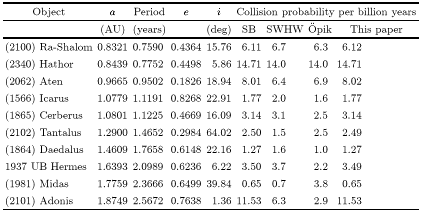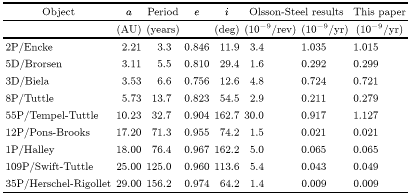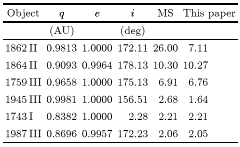This algorithm was designed to calculate efficiently the collision
probability per unit time between objects moving in arbitrary elliptical
orbits. The algorithm has been tested in a variety of ways and against a
number of previous results. First we compare our results with those of
Wetherill (1967) and subsequent workers, who have determined the
intrinsic collision probability between a number of selected comets and
asteroids against a hypothetical test body, Astrid', with orbital
elements ![]() .The results are shown in Table 1, which shows excellent agreement
with the independent results of Namiki & Binzel (1991)
and Bottke &
Greenberg (1993), denoted N&B1, N&B2 and BG respectively.
.The results are shown in Table 1, which shows excellent agreement
with the independent results of Namiki & Binzel (1991)
and Bottke &
Greenberg (1993), denoted N&B1, N&B2 and BG respectively.
 |
 |
 |
Next we evaluated the impact probabilities of selected objects with the Earth. Table 2 shows the comparison between a number of Apollo and Aten asteroids, with orbital elements and other data from Shoemaker et al. (1979) and results from the Öpik method taken from Steel & Baggaley (1985). Table 3 gives corresponding results for comets, taken from Olsson-Steel (1987), and Table 4 shows the equivalent comparison for long-period comets with extremely high impact probabilities, with elements taken from Marsden & Steel (1994).
These results are also in good agreement with those of previous authors, with several notable exceptions, namely: (2101)Adonis (Table 2), 1862II = C/1862N1 and 1945III = C/1945L1 (Table 4). The first of these is close to a singularity at low inclination; the second and third have perihelion distances close to that of the Earth. As we have discussed, most methods for evaluating the collision probability experience singularities at very low and very high relative inclinations, and when either the perihelion or aphelion of one orbit is in close proximity to those points in the other orbit. These minor differences show that further work is required in order to determine the precise value of the impact probability for some of these more extreme cases.
We have confirmed that the mean terrestrial impact probability pE for
an isotropic flux of nearly parabolic orbits with perihelion distances
uniformly distributed in the interval 0-1AU is
![]() per revolution (cf. Weissman 1997 and refs. therein), with a mean
impact velocity including gravitational focusing of 54.9km s-1.
Alternative expressions for the frequency distribution of long-period
comets versus perihelion distance (Everhart 1967;
Kresák 1978)
generally show an increase with perihelion distance. This leads to a
higher average terrestrial impact probability, namely:
per revolution (cf. Weissman 1997 and refs. therein), with a mean
impact velocity including gravitational focusing of 54.9km s-1.
Alternative expressions for the frequency distribution of long-period
comets versus perihelion distance (Everhart 1967;
Kresák 1978)
generally show an increase with perihelion distance. This leads to a
higher average terrestrial impact probability, namely:
![]() per revolution, for what
Kresák (1978) respectively calls Everhart's empirical and alternative models,
and Kresák's uniform density model. The observed long-period
comets, whilst not necessarily representative of the intrinsic
near-parabolic flux, show an even stronger increase with perihelion
distance towards 1AU, and give a mean impact probability of
per revolution, for what
Kresák (1978) respectively calls Everhart's empirical and alternative models,
and Kresák's uniform density model. The observed long-period
comets, whilst not necessarily representative of the intrinsic
near-parabolic flux, show an even stronger increase with perihelion
distance towards 1AU, and give a mean impact probability of ![]() per revolution (cf.
Shoemaker 1984;
Olsson-Steel 1987).
per revolution (cf.
Shoemaker 1984;
Olsson-Steel 1987).
 |
In order to test the performance of the algorithm with a large ensemble,
we examined the set of 682 asteroids with diameters D>50km used by
Farinella & Davis (1992) and later by
Bottke et al. (1994) and
Vedder (1998). The distribution of collision velocities was determined for every
interacting pair and the total summed distribution is shown in
Fig. 4.
The mean colision velocity is 5.30 km s-1, which may be compared
with the values calculated by
Farinella & Davis (1992);
Bottke et al. (1994)
and Vedder (1998) of ![]() km s-1,
km s-1, ![]() km s-1 and
km s-1 and
![]() km s-1 respectively. Similarly, the intrinsic collision
probability for this sample (assuming a diameter of 1km for each
object, i.e. corresponding to an interaction cross-section of
km s-1 respectively. Similarly, the intrinsic collision
probability for this sample (assuming a diameter of 1km for each
object, i.e. corresponding to an interaction cross-section of ![]() km2; cf. Table 1), is
km2; cf. Table 1), is ![]() yr-1 km-2,
which may be compared with the values
yr-1 km-2,
which may be compared with the values ![]() yr-1
km-2 and
yr-1
km-2 and ![]() yr-1 km-2 reported by
Farinella & Davis (1992)
and Vedder (1998) respectively. The method of
the latter author appears to lead to a slightly lower mean impact
velocity and a slightly higher mean intrinsic collision probability. Use
of the present algorithm resulted in a total collision probability for
the 682-asteroid ensemble of
yr-1 km-2 reported by
Farinella & Davis (1992)
and Vedder (1998) respectively. The method of
the latter author appears to lead to a slightly lower mean impact
velocity and a slightly higher mean intrinsic collision probability. Use
of the present algorithm resulted in a total collision probability for
the 682-asteroid ensemble of ![]() yr-1, implying a
mean time
yr-1, implying a
mean time ![]() 140Myr for collisions between objects in the ensemble.
Collisions between these large objects could result in the formation of
asteroid families, and possibly showers of kilometre-sized fragments on
Earth-crossing orbits via fast-track resonant dynamical pathways
(Zappalà et al. 1998).
140Myr for collisions between objects in the ensemble.
Collisions between these large objects could result in the formation of
asteroid families, and possibly showers of kilometre-sized fragments on
Earth-crossing orbits via fast-track resonant dynamical pathways
(Zappalà et al. 1998).
 |
Figure 4: The figure shows the frequency distribution of collision velocities for main-belt asteroids with diameters d > 50 km |
Copyright The European Southern Observatory (ESO)